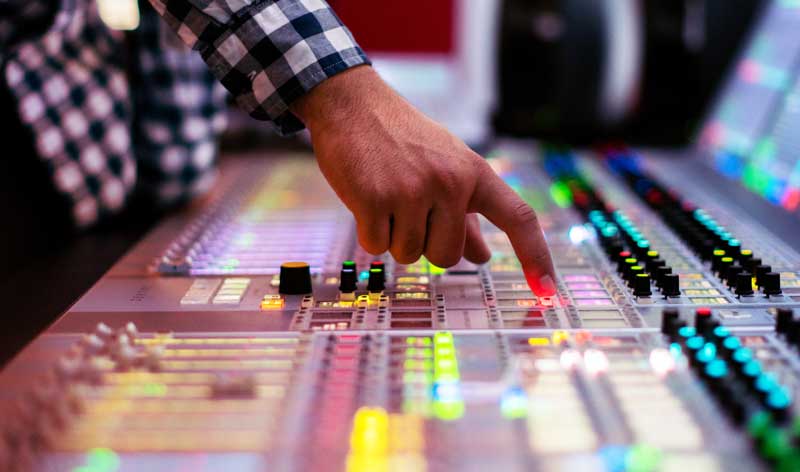OUR FLAGSHIP PROGRAM

DIPLOMA IN SOUND ENGINEERING & SOUND RECORDING
Eligibility : 10 /+2
Diploma Duration : 1 Year ( 2 - Semesters )
The diploma programme is designed in such a way that it will make a newcomer to enter into the Pro – Audio Industry. Our unique Teaching – Learning – Evaluation methodology will make the student a professional, professionally. It is designed in such a way that the students can learn the subject From the very basics to its advanced level with state-of -the-art facilities and expert faculty guidance.
Course Modules
1. Audio Fundementals
• What is Sound ?
• Frequency, Wavelength, and Period
• Frequency and period
• Wavelength
• Transduction: Acoustic to Electric
• Amplitude
• Complex Waves
2. Audio Electronics
• Basic Electricity
• AC & DC Generation and Distribution
• Electrical accessories & control systems
• Electrical wiring Protocol &Standards
• Electrical Safety
• Basic Electronics
3. Audio Electronics Continued
• Pro Audio equipment & accessories familiarization
• Audio connectors & cables
• Assembly of practical audio cables
• Interconnectivity of audio equipment
• Lab Practice & Documentation
• Project
4. Microphone
• Electromagnetic Induction
• Types of micro phone
• Microphone Specifications: Frequency Response
• Sensitivity and Polar Response
• Omni-Directional and Cardiod Microphones
• Hypercardiod and Supercardiod Microphones
• Shotgun Microphones
• Bi-Directional / Figure-of-8 Microphones
5. Amplifiers & Loud Speakers
• Loudspeakers
• Moving-Coil Loudspeakers
• Electrostatic Loudspeakers
• Baffle Types
• Infinite Baffle
• Loudspeaker Specifications Amplifiers Over view
• Types of Amplifiers
6. Signal Flow
• Signal-Flow Principles and Symbols
• Effective Steps for Generating a Signal Flow
• Radio Signal Flow
• Home Theater Receiver Signal Flow
• Mixer Signal Flow
• Advanced Signal Flow: The Recording Console
7. Digital Mixing Consoles & Controllers
• The Digital Console
• Analog and Digital I/O
• Input/output Matrix
• Paged Architecture
• Select/Focus Channel
• Channel Strip
• The DAW Controller
8. Signal Processors
• Types Of Processors
• Internal & External Processors
• Signal Flow
• Effect Processors
• Compressors & Limiters
• DSP
• Cross Over 2 Way – 3 Way
9. EQ & Dynamics
• EQ Types
• Shaping sounds with EQ
• Using EQ Effectively
• Intro to Dynamics Processors: Gates and Expanders
• Compressors and Limiters
10. Reverb & Acoustic Space
• Understanding Reverb Parameters
• Strategies for Using Reverb in a Mix
• Processing Reverb Sends and Creating
• Multiple Reverb Sends
• The AIR Reverb Plug-ins
• Sending to an External Reverb
11. Delay, Chorus & Flanging
• Introduction to Delay and Delay Parameters
• Short Delays: Timbre Effects and Flanging
• Doubling and Chorusing
• Longer delays; Slap back and Tempo Delays
12. Mixing
• Concept of Mixing Music
• Setting up a Mixing Session
• Dealing with Equalization
• Effect Processing
• Automation Techniques
• Dynamics Processing
13. Daw Signal Flow
• Digital Signal Routing & Digital I/O
• DAW Input/Output Matrix
• Templates
• Audio Tracks vs. “Voices”
• MIDI Tracks
• Virtual Instrument Tracks
• VCA Masters
• Auxiliary (Aux) Inputs
• Busses
• Serial vs. Parallel Processing
14. Recording Studio
• Input Sources
• Signal Output
• Microphones
• The A/D Converters
• Recording Signal Flow
• Monitoring Playback
• Adding the Console
• Combining Signals
• Complete Signal Flow
• Busses
• Serial vs. Parallel Processing
15. Introduction To Post Production
• Audio Post Production Overview
• Assessing the Post Elements in a QuickTime Movie
• The History and Evolution of Sound for Film
and Theater
• Basic Pro Tools Set Up for Post Production
• Importing a QuickTime Movie into Your Pro Tools
Session
16. Post Production In Depth
• The Process, Methods, Tools, and People of Production and Post Production
• Post Production Media
• Digital Audio File Formats
• Film and Video Formats and Applications
• Synchronization
• Ensuring that the SMPTE Reader in Pro Tools and
QuickTime are the Exact Same
17. Location Sound Recording
• The Process, Methods, and Tools of Location Sound
• Introduction to the Location Sound Crew
• In Depth Look at Transfers
• Reviewing and Assessing the Location
Sound Schedule for a Feature Film
18. Mixing Music
• Overview of Mixing
• Mixing = Balance
• Panning
• Muting Techniques
• Designing a Mixer in Pro Tools and
QuickTime are the Exact Same
19. Accoustic
• Modes and Harmonics
• Decibels and Octaves
• Sound Level Measurement
• Room Acoustics
• Sound Isolation
20. Live Sound Reinforcement
• Introduction to live sound
• Roles in live sound production
• Live Sound Reinforcement Signal Flow
• Venue practicals
• System Design
• Backline
• Gain Before Feedback
• Microphone Choice and Placement
21. Live Sound Reinforcement Continued
• Power
• Rigging
• System Tuning
• Wireless Technology
• Sound Check
• Show Time
• Safety

